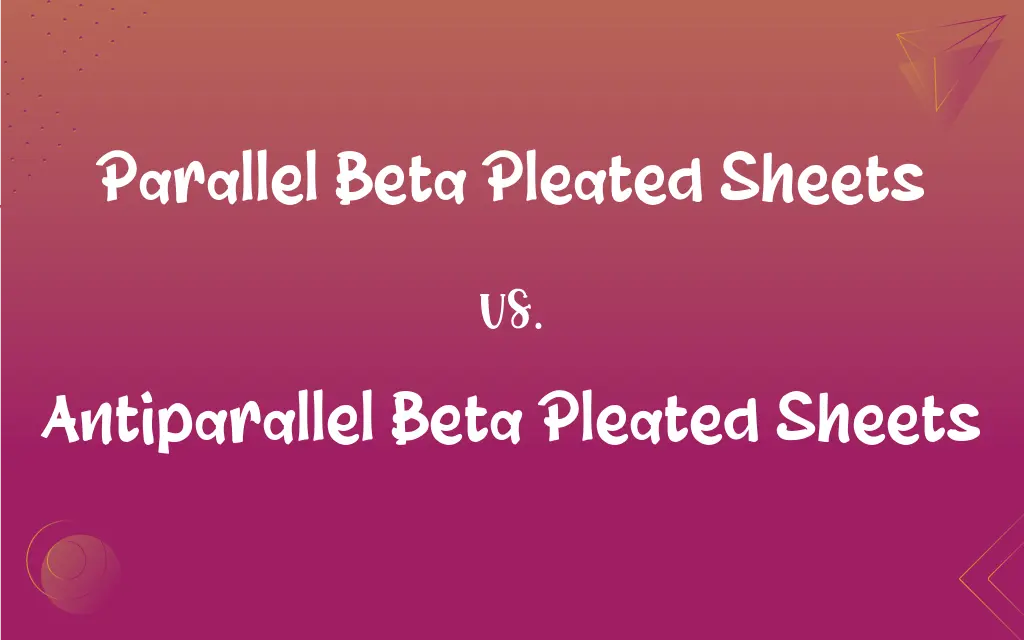Parallel Beta Pleated Sheets vs. Antiparallel Beta Pleated Sheets: What's the Difference?
Edited by Aimie Carlson || By Harlon Moss || Published on February 10, 2024
Parallel beta pleated sheets have aligned polypeptide chains running in the same direction, whereas antiparallel beta pleated sheets have adjacent strands running in opposite directions.

Key Differences
Parallel beta pleated sheets in protein structures feature polypeptide chains running side by side in the same direction, leading to a specific hydrogen bonding pattern. Antiparallel beta pleated sheets, in contrast, have adjacent strands running in opposite directions, resulting in a different hydrogen bonding arrangement.
The hydrogen bonds in parallel beta pleated sheets are aligned diagonally, which can make them slightly less stable compared to the antiparallel arrangement. In antiparallel beta pleated sheets, the hydrogen bonds are more directly aligned between the strands, contributing to greater stability.
Parallel beta pleated sheets often appear in fibrous proteins and enzymes, where their specific alignment plays a functional role. Antiparallel beta pleated sheets are common in globular proteins and are known for their structural rigidity and stability.
The structure of parallel beta pleated sheets can affect the protein's overall properties, like elasticity and interaction with other molecules. Antiparallel beta pleated sheets typically contribute to the protein's strength and compactness, important in many biological functions.
In parallel beta pleated sheets, the N-terminus of all participating strands is oriented in the same direction. In antiparallel sheets, the N-terminus of one strand aligns with the C-terminus of the adjacent strand, reflecting their opposite directional alignment.
ADVERTISEMENT
Comparison Chart
Strand Alignment
Polypeptide chains run in the same direction.
Adjacent strands run in opposite directions.
Hydrogen Bonding
Diagonally aligned hydrogen bonds.
Directly aligned hydrogen bonds.
Stability
Slightly less stable due to bonding pattern.
More stable due to direct hydrogen bonding.
Common Occurrence
Fibrous proteins and some enzymes.
Common in globular proteins.
Structural Features
Affects elasticity and molecule interaction.
Contributes to protein strength and compactness.
ADVERTISEMENT
Parallel Beta Pleated Sheets and Antiparallel Beta Pleated Sheets Definitions
Parallel Beta Pleated Sheets
N-termini of strands oriented in the same direction.
The alignment of N-termini in these parallel beta pleated sheets is crucial for their function.
Antiparallel Beta Pleated Sheets
Characterized by directly aligned hydrogen bonds.
The direct hydrogen bonding in antiparallel beta pleated sheets enhances stability.
Parallel Beta Pleated Sheets
Influences protein elasticity and interactions.
The parallel beta pleated sheets in this protein contribute to its elasticity.
Antiparallel Beta Pleated Sheets
Contributes to protein strength and compact structure.
The antiparallel beta pleated sheets in this protein ensure its rigidity.
Parallel Beta Pleated Sheets
Protein structure with chains running in the same direction.
The parallel beta pleated sheets in this enzyme affect its activity.
Antiparallel Beta Pleated Sheets
Protein structure with strands running in opposite directions.
Antiparallel beta pleated sheets provide structural integrity to this protein.
Parallel Beta Pleated Sheets
Common in certain fibrous proteins.
Silk's strength is partly due to its parallel beta pleated sheets.
Antiparallel Beta Pleated Sheets
Predominantly found in globular proteins.
Many enzymes have antiparallel beta pleated sheets for compactness.
Parallel Beta Pleated Sheets
Features diagonally aligned hydrogen bonds.
The unique hydrogen bonding in parallel beta pleated sheets impacts their stability.
Antiparallel Beta Pleated Sheets
N-terminus of one strand aligns with the C-terminus of another.
The N- and C-termini alignment in antiparallel beta pleated sheets is key to their structure.
FAQs
What are parallel beta pleated sheets?
Protein structures with strands running parallel to each other.
Why are antiparallel beta pleated sheets more stable?
Their directly aligned hydrogen bonds contribute to stability.
Where are parallel beta pleated sheets commonly found?
In fibrous proteins and certain enzymes.
What is the typical occurrence of antiparallel beta pleated sheets?
They are common in globular proteins.
How do parallel beta pleated sheets affect protein function?
They influence elasticity and molecular interactions.
What role do antiparallel beta pleated sheets play in proteins?
They add strength and compactness to protein structures.
Can both types of beta pleated sheets exist in one protein?
Yes, some proteins contain both parallel and antiparallel sheets.
What is the significance of hydrogen bonding in these structures?
Hydrogen bonds are crucial for the stability and formation of these sheets.
What defines antiparallel beta pleated sheets?
Strands running in opposite directions in a protein structure.
Are parallel beta pleated sheets less stable than antiparallel?
Generally, yes, due to their diagonal hydrogen bonding pattern.
Do parallel beta pleated sheets contribute to protein flexibility?
They can contribute to a certain degree of flexibility.
Can the type of beta pleated sheet affect a protein's properties?
Yes, the type can impact the protein's stability, function, and interaction.
Is the presence of beta pleated sheets indicative of protein complexity?
They are a common feature in complex protein structures.
Can mutations affect the formation of these beta pleated sheets?
Yes, mutations can disrupt their formation and lead to protein dysfunction.
Is the N-terminus alignment the same in both structures?
No, parallel sheets have same-direction N-termini, antiparallel have alternating N- and C-termini.
Are antiparallel beta pleated sheets involved in enzyme function?
Yes, they can play a significant role in enzyme structure and function.
How does the orientation of strands in antiparallel sheets benefit proteins?
It provides structural integrity and compactness.
Do parallel beta pleated sheets have any unique properties?
Their diagonal hydrogen bonding and directionality are unique aspects.
Are these beta pleated sheets visible under a microscope?
They are typically observed using techniques like X-ray crystallography.
Are beta pleated sheets a focus in protein engineering?
Yes, understanding their formation is important in protein design and engineering.
About Author
Written by
Harlon MossHarlon is a seasoned quality moderator and accomplished content writer for Difference Wiki. An alumnus of the prestigious University of California, he earned his degree in Computer Science. Leveraging his academic background, Harlon brings a meticulous and informed perspective to his work, ensuring content accuracy and excellence.
Edited by
Aimie CarlsonAimie Carlson, holding a master's degree in English literature, is a fervent English language enthusiast. She lends her writing talents to Difference Wiki, a prominent website that specializes in comparisons, offering readers insightful analyses that both captivate and inform.







































































